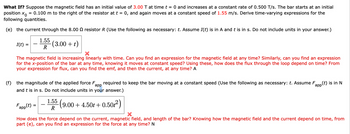Question

Transcribed Image Text:What If? Suppose the magnetic field has an initial value of 3.00 T at time t = 0 and increases at a constant rate of 0.500 T/s. The bar starts at an initial
position X
= 0.100 m to the right of the resistor at t = : 0, and again moves at a constant speed of 1.55 m/s. Derive time-varying expressions for the
following quantities.
(e) the current through the 8.00 Q resistor R (Use the following as necessary: t. Assume I(t) is in A and t is in s. Do not include units in your answer.)
I(t)
=
1.55
R
(3.00+t)
The magnetic field is increasing linearly with time. Can you find an expression for the magnetic field at any time? Similarly, can you find an expression
for the x-position of the bar at any time, knowing it moves at constant speed? Using these, how does the flux through the loop depend on time? From
your expression for flux, can you find the emf, and then the current, at any time? A
app
(f) the magnitude of the applied force F₂ required to keep the bar moving at a constant speed (Use the following as necessary: t. Assume F
and t is in s. Do not include units in your answer.)
(t) is in N
app
Fapp(t):
R
1.55 (9.0
9.00 +4.50 +0.50²)
×
How does the force depend on the current, magnetic field, and length of the bar? Knowing how the magnetic field and the current depend on time, from
part (e), can you find an expression for the force at any time? N

Transcribed Image Text:In the figure below, a steel bar sitting on two parallel metal rails, connected to each other by a resistor, is pulled to the right with a constant force of
magnitude F = 1.45 N. The friction between the bar and rails is negligible. The resistance R = 8.00, the bar is moving at a constant speed of 1.55 m/s,
app
the distance between the rails is {, and a uniform magnetic field B is directed into the page.
w
R
Fapp
i
Expert Solution
This question has been solved!
Explore an expertly crafted, step-by-step solution for a thorough understanding of key concepts.
Step by stepSolved in 2 steps with 2 images
